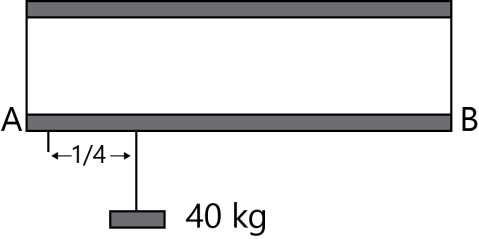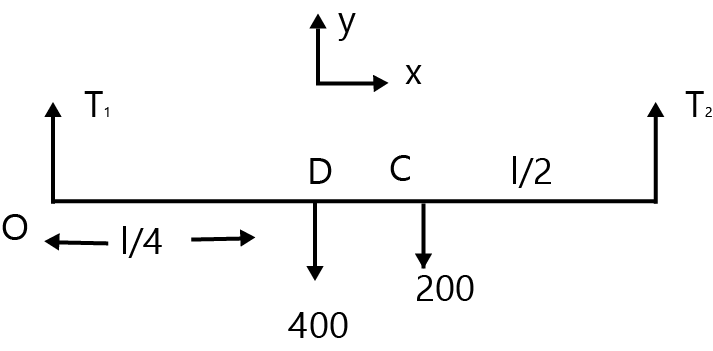
A uniform rod of 20 kg is hanging in a horizontal position with the help of two threads. It also supports a 40 kg mass as shown in the figure. Find the tensions developed in each thread.

Answer
220.8k+ views
Hint: We will draw a free body diagram. We will calculate tension in string using translational equilibrium using $\Sigma F = 0$. Then using rotational equilibrium $\tau = 0$, we will calculate individual tensions at point C and D.
Complete step by step answer:

Free body diagram is shown in the figure.
Translational Equilibrium:
A body moving with constant velocity or no acceleration. Then it is said to possess translational equilibrium.
$\Sigma F = 0$
$ \Rightarrow \Sigma \,m\,a = 0$
$ \Rightarrow a = 0$
$ \Rightarrow \dfrac{{dv}}{{dt}} = 0$
$v = const$
Rotational Equilibrium:
A body experiencing a constant rotational velocity or no angular acceleration.
$\Sigma \tau = 0$
$\Sigma \,r \times F = 0$
$F = 0$
In this case object shows a rotational motion in only one direction at a constant angular velocity
$\omega = 0$
According to translational equilibrium
$\Sigma {F_y} = 0$
$ \Rightarrow {T_1} + {T_2} = 0$
${T_1}$= tension in string where 40 kg mass is hanged at a distance of $\dfrac{l}{4}$
${T_2}$= tension in string lying at a distance of $\dfrac{l}{2}$ at point C as shown in figure.
$ = 40 \times 10 + 20 \times 10$
$ = 400 + 200N$
$ = 600N$
According to rotational equilibrium
Applying at A, we get
${\tau _A} = 0$
$ \Rightarrow - 400\,(l/4) - 200(l/2) + {T_2}l = 0$
${T_2} = 200N$
${T_1} = 100N$
Therefore, tension in string AB is 600 N and tensions at point D and C is 200 N and 100 N respectively.
Note:
If value of g is taken as $9.8\,\dfrac{m}{{{{\sec }^2}}}$instead of $10\dfrac{m}{{{{\sec }^2}}}$ then values would have been different. If the object would have been accelerating then there would be no equilibrium.
Since the direction in which force is acting at point C and D is opposite to point A and B do opposite signs will be used while doing calculation. Negative signs used while calculating torque indicates direction.
Complete step by step answer:

Free body diagram is shown in the figure.
Translational Equilibrium:
A body moving with constant velocity or no acceleration. Then it is said to possess translational equilibrium.
$\Sigma F = 0$
$ \Rightarrow \Sigma \,m\,a = 0$
$ \Rightarrow a = 0$
$ \Rightarrow \dfrac{{dv}}{{dt}} = 0$
$v = const$
Rotational Equilibrium:
A body experiencing a constant rotational velocity or no angular acceleration.
$\Sigma \tau = 0$
$\Sigma \,r \times F = 0$
$F = 0$
In this case object shows a rotational motion in only one direction at a constant angular velocity
$\omega = 0$
According to translational equilibrium
$\Sigma {F_y} = 0$
$ \Rightarrow {T_1} + {T_2} = 0$
${T_1}$= tension in string where 40 kg mass is hanged at a distance of $\dfrac{l}{4}$
${T_2}$= tension in string lying at a distance of $\dfrac{l}{2}$ at point C as shown in figure.
$ = 40 \times 10 + 20 \times 10$
$ = 400 + 200N$
$ = 600N$
According to rotational equilibrium
Applying at A, we get
${\tau _A} = 0$
$ \Rightarrow - 400\,(l/4) - 200(l/2) + {T_2}l = 0$
${T_2} = 200N$
${T_1} = 100N$
Therefore, tension in string AB is 600 N and tensions at point D and C is 200 N and 100 N respectively.
Note:
If value of g is taken as $9.8\,\dfrac{m}{{{{\sec }^2}}}$instead of $10\dfrac{m}{{{{\sec }^2}}}$ then values would have been different. If the object would have been accelerating then there would be no equilibrium.
Since the direction in which force is acting at point C and D is opposite to point A and B do opposite signs will be used while doing calculation. Negative signs used while calculating torque indicates direction.
Recently Updated Pages
Two discs which are rotating about their respective class 11 physics JEE_Main

A ladder rests against a frictionless vertical wall class 11 physics JEE_Main

Two simple pendulums of lengths 1 m and 16 m respectively class 11 physics JEE_Main

The slopes of isothermal and adiabatic curves are related class 11 physics JEE_Main

A trolly falling freely on an inclined plane as shown class 11 physics JEE_Main

The masses M1 and M2M2 M1 are released from rest Using class 11 physics JEE_Main

Trending doubts
JEE Main 2026: Application Form Open, Exam Dates, Syllabus, Eligibility & Question Papers

Understanding Uniform Acceleration in Physics

Derivation of Equation of Trajectory Explained for Students

Hybridisation in Chemistry – Concept, Types & Applications

Understanding the Angle of Deviation in a Prism

How to Convert a Galvanometer into an Ammeter or Voltmeter

Other Pages
Thermodynamics Class 11 Physics Chapter 11 CBSE Notes - 2025-26

JEE Advanced Marks vs Ranks 2025: Understanding Category-wise Qualifying Marks and Previous Year Cut-offs

Units And Measurements Class 11 Physics Chapter 1 CBSE Notes - 2025-26

NCERT Solutions For Class 11 Physics Chapter 8 Mechanical Properties Of Solids

Motion in a Straight Line Class 11 Physics Chapter 2 CBSE Notes - 2025-26

Laws of Motion Class 11 Physics Chapter 4 CBSE Notes - 2025-26




